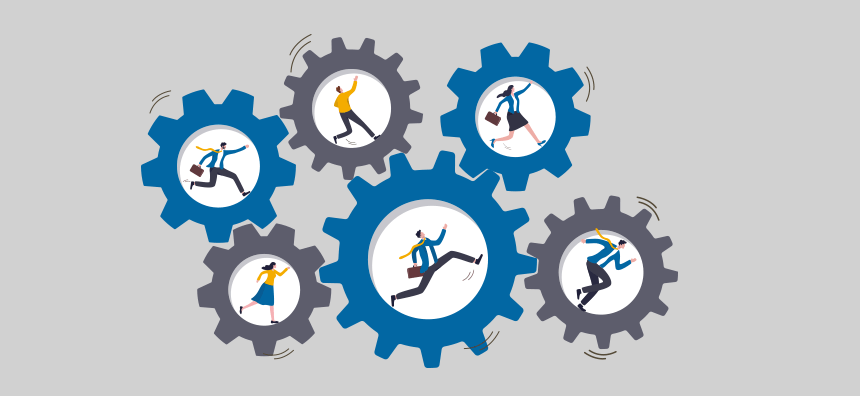
Click the button to start reading
How to Measure Employee Engagement
Employee engagement has become somewhat of a buzzphrase in the last decade. We hear it a lot, but what does it actually mean? Fundamentally, an engaged employee is a person that is dedicated and enthusiastic about their job and the success of the organization they’re a part of.
There are many reasons why businesses would like to have an engaged workforce—some of the most important ones are increased productivity and low employee turnover rates. These people care—their passion goes beyond the paycheck.
A critical part of improving employee engagement is understanding what your company is doing right and the things it can improve on. Once that’s done, you’ll be able to identify KPIs that need extra attention, which will, in turn, fuel your employee engagement strategy.
In this article, we’ll take a closer look at how businesses should go about measuring the engagement of their staff and the value that it brings to the table.
Let’s dive right in, shall we?

Why does employee engagement matter?
As of recently, employee engagement has become a priority for businesses worldwide—and there are plenty of reasons for it. We’ve mentioned above, an engaged workforce is more productive and loyal, but it’s also likely to lead to greater customer satisfaction, better reputation, and overall stakeholder value.
Gallup, a reputable analytics and advisory company, has been measuring the engagement of the US workforce since the year 2000. Some of their latest reports on the topic suggest that North-American employees are more enthusiastic and committed to their work. However, they only constitute about a third of the total number of workers, which is pretty unsettling if you think about it. Nearly 17% of people are actively disengaged, while the rest (about half) are somewhat disengaged.
There is a broad spectrum of things that can influence employee engagement—meaningful relationships with coworkers, enjoying the support of upper management, skillsharing, alignment with the organization’s goals, and so forth. Fundamentally, every worker wants to feel valued and respected—we all want to know that what we do matters and that our voices are heard at work.

The engaged and the disengaged: a world of difference
A person that is engaged at work doesn’t typically see their job as an obligation but more of a chance to excel. On the other hand, disengaged workers often need to be stimulated to work on an hourly basis—their pessimism pervades their workday and affects their colleagues as well, which acts as a detracting force for them. This lack of engagement can also affect your organization’s clientele if your customer-facing employees feel unenthused about their jobs.
There’s a growing body of research that underlines the overwhelming effect lack of engagement has over businesses on an annual basis. For instance, one study suggests that US-based companies lose around $350 billion of lack of engagement alone—yes, “billion” with a B. As exorbitant as these figures may be, it’s safe to say that they don’t come as a surprise. After all, only a third of the employees in the United States are actually engaged at work—and organizations are missing out because of it.
According to a Towers Perrin study, nearly 85% of workers who identify as engaged believe it is within their reach to provide their companies with value. Disengaged employees believe that as well. However, only a third of them do. The differences don’t stop here. Let’s take a quick look at the critical differences between engaged and disengaged employees:
| Engaged workers | Disengaged workers |
| Positive outlook | Negative outlook |
| Team-oriented | Self-centered |
| Delivers beyond expectation | High absenteeism |
| Solution-oriented | Negative attitude |
| Passes along credit but accepts blame | Accepts credit but passes along blame |
How do you measure employee engagement?
Given how complex and multifaceted employee engagement is, organizations should consider exploring multiple ways of measuring it. The tools available for establishing it are fairly limited, and looking into a couple of metrics and research methods will yield more confident results. Here are a few of them.
Employee net promoter score (eNPS)
Net Promoter Score (NPS) is a common metric used by marketers, UX designers, UX researchers, and a wide array of different professionals. The main idea behind it is to understand how many clients are loyal to your brand and whether they would recommend your product or services to their friends and family.
On the other hand, employee Net Promoter Score (eNPS) is a similar metric that aims to gauge employee loyalty. Measuring eNPS, like NPS, is pretty straightforward—ask your employees how likely it is for them to recommend the company as a good place to work.
The data for this metric is collected via a one-question survey. Typically, employees have to rate how likely it is that they would recommend their workplace on a scale from 1 to 10. One, in this case, means that it’s highly unlikely, while ten means that it’s very likely. It’s essential that your employees’ answers are anonymous.
Once you’ve collected the data, it’s time to segment them into three categories: detractors (0-6), passives (7-8), and promoters (9-10).
It’s worth mentioning that this metric won’t provide you with an in-depth understanding of the reasons why people are or are not happy with working in your organization, but it does offer a better understanding of the engagement climate in the company.
Pulse surveys
Pulse surveys are designed to provide short-term snapshots of your employees’ satisfaction and engagement. You can run them once a quarter, month, or even week.
When it comes to pulse surveys, it’s always a good idea to repeatedly ask at least some of the questions. This will allow you to gauge the progress on certain parameters over time and understand whether the measures you’ve applied have worked. This will let you know where to focus your efforts to have the biggest impact on your workforce’s engagement.
However, it’s important to underline that while quick and frequent surveys can provide you with lots of valuable data, organizations shouldn’t base their entire engagement strategies on them. They’re an awesome tool that can help you uncover potential issues, but at the same time, they often lack depth and can’t really provide you with a lot of actionable insight.
Stay interviews
Exit interviews are a standard in modern organizations—it’s a useful practice that allows human resources and upper management to understand what motivates their employees to leave the company. However‚ it also begs the question, “why even wait for people to leave?”.
Stay interviews allow you to understand what people like about working in a company, as well as the biggest challenges and roadblocks they have to deal with. They are a source of valuable information that helps businesses understand how to improve their employees’ experience at work. It’s fair to say that this is a far more productive and actionable approach that will also help decrease employee turnover.
Employee absenteeism and turnover rate
We all know that engaged workers are enthusiastic and passionate about their work, but sometimes the focus of your research should be aimed at those who aren’t.
A good way of gauging how your workers feel is by taking a closer look at turnover rates and absenteeism. While both of them are lagging indicators, they can provide you with a better understanding of how engaged or disengaged people are.
According to Gallup, organizations should aim to keep their annual turnover rates below 10 percent. Some turnover might actually be good for the company—it allows dissatisfied people to seek more suitable opportunities, which will help the company grow. However, high staff attrition means that you’re losing lots of money previously invested in hiring them, but more importantly, it suggests that some aspects of the organization are seriously mismanaged.
Furthermore, analyzing absenteeism and attrition in particular teams and departments may show if managers are doing their best to keep their colleagues engaged and satisfied with their work environment.
Aside from establishing how many employees choose to leave your organization and whether the number is too high, it’s important to learn about the reasons behind their decisions, which brings us back to stay interviews.

Employee resilience
An essential quality of an engaged employee is their ability to continuously adapt to the changes in the organization. This quality is typically called “resilience,” and resilient employees are most likely to spend more time working in the organization, which comes with a wide array of benefits.
There’s no quick answer to how resilient your employees are since this is a fairly complex parameter. It includes indicators such as self-efficacy, optimistic outlook on the company’s future, social support, and others.
However, there is a clear gap between employees that are resistant to change and those who are not. The former will most likely spend at least 3-4 years in your organization, while the latter will probably end up leaving in under 12 months.
In order to assess the resilience of every individual employee, companies should gather data via polls and surveys. These research methods need to be designed around a person’s commitment to the workplace and the leadership within the organization. Similarly, these studies should explore whether employees can maintain a healthy work-to-life balance during their tenure at the job. However, it’s essential to underline that it’s not exclusively the employees’ responsibility to manage their work-to-life balance—organizations can and should invest resources in improving this aspect of employee experience.
Here are a few relevant questions that you can ask your employees to get a better understanding of their wellbeing at work:
- How do you find your current work environment?
- Are you able to manage your work-to-life balance efficiently?
- Do you feel like you’re able to build meaningful relationships at work?
- Is there anything you would like to discuss or need help with?
Focus groups
One-on-one calls and meetings are a very useful way of understanding how engaged your workforce is, but it isn’t the most feasible approach if you have a few hundred or thousand employees. Focus groups are a better way to gauge the engagement climate in large organizations, as well as understand their pet peeves, likes, and attitudes.
When organizing a focus group, it’s important to put together a fairly diverse set of participants from different teams and departments in order to get a broader outlook on things. During these sessions, you can present the participants with potential changes you’re looking to introduce in order to see how they feel about them. Similarly, you can hold conversations with them on specific topics about their experience at work. Here are a few examples:
For engagement-focused insights, ask questions like:
- Do you have a good sense of your role in contributing to organizational goals?
- Is there anything that’s limiting your growth in the organization?
- Do you agree about the way our company defines “success”?

Employee retention
We mentioned above that employee resilience is somewhat correlated with engagement, which is why employee retention is also a good way to understand how enthusiastic your staff is about working in your organization.
Another important aspect that organizations should keep an eye on are age groups and gender. For example, if there is a disproportionate number of women leaving your organization, there might potentially be discrimination issues that need to be addressed in your workplace. Respectively, it’s important to invest time and resources in promoting gender equality.
Employee productivity
Given that there is a strong relationship between engagement and productivity, it’s always a good idea to measure the latter to understand the former.
Productivity is somewhat of an elusive concept, and different organizations may choose to measure them in different ways, depending on the industry they’re in and a host of other parameters. However, there is a universal way of understanding how productive your employees are—divide your revenue for a particular timeframe by the total number of workers in your organization. This will allow you to establish a baseline and assess how the productivity of your workforce grows or declines over specific periods of time.
However, it’s worth mentioning that your productivity metrics will vary significantly depending on the type of business you’re in. Similarly, it’s always a good idea to measure the productivity in different teams and departments in order to get a more granular view of your employees’ output.
The bottom line
Engaged employees are an essential asset for the success of an organization. However, it would be incorrect to expect your employees to be enthusiastic about their jobs by default—companies should invest time and money into a well-thought-out engagement strategy that prescribes best practices regarding job design, training, compensation, performance management, and a wide array of other parameters.
















